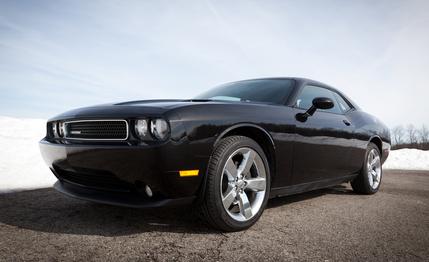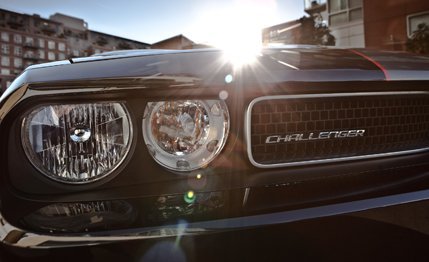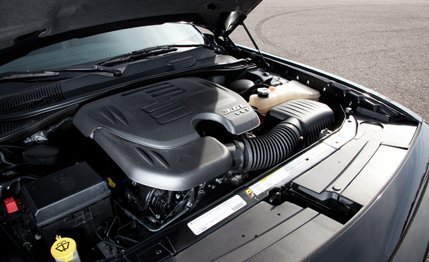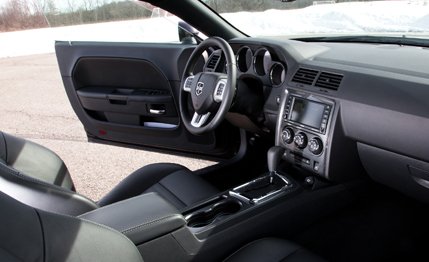
 Short Take Road Test
Short Take Road Test
What Is It?
It’s Dodge’s portly and nostalgia-slathered muscle pony, now with nicer interior materials and a new base engine: the 3.6-liter Pentastar V-6. That means 305 hp instead of the old 3.5-liter V-6’s 250, as well as a modest torque increase of 18 lb-ft to 268. Dodge Challenger 2011: The Freshening also gives star turns to newly standard auto climate control, keyless entry and start, side airbags, and 18-inch wheels, plus reworked front and rear suspension setups and a revised brake system. (Oh, and the chrome fuel flap is standard this year, too.) The $1500 Super Sport Group (SSG) is new and includes a shorter rear-axle ratio, sportier suspension and steering calibrations, uprated brakes, stickier tires, and 20-inch wheels. Our test car was equipped with this package, which first requires the $2000 Rallye bundle (some luxury and audio items and fog lamps).
Delving deeper into the chassis tweaks, the suspension overhaul means new shocks, springs, and bushings across the range. Dodge has dialed in more negative camber at all four corners and installed larger anti-roll bars at the front and rear. The brakes on all Challengers have a shorter pedal travel, and the SSG’s upgrades bring larger and thicker front discs and thicker and vented rear discs.
How Does It Drive?
Better. The SSG brakes improved pedal feel and cut a whopping 21 feet from the 70-to-0-mph stopping distance of a V-6 Challenger we previously tested. The steering in our car was more informative than before and had less slop. The revised suspension had diminished impact harshness, imparted more eagerness on turn-in, and improved straight-line stability.


But the car is still a huge porky porkster—3958 pounds in this case, about 150 more than a V-6 Camaro and 430 more than a V-6 Mustang—so most of what the chassis has to do is mitigate mass. There’s only so much the engineers could do to improve transient response and ride quality. Even though the Challenger changes direction more readily, the overriding impression is that the car would rather continue in a straight line, thank you very much. This is probably about as good as the base Challenger is going to get without dropping a few hundred pounds.
How Does It Stack Up?
Although better to drive, the Challenger is still topped by the Camaro, which is itself roundly trumped by the agile and satisfying Mustang. The base Challenger was really underpowered before, and with 55 extra ponies, it’s, well, still underpowered. True, the car’s 6.4-second 0-to-60 sprint isn’t bad for something weighing two tons and motivated by six cylinders—and it’s an improvement of more than a second over the previous model—but the 2011 Challenger V-6 trails the Camaro V-6 (312 hp) to 60 mph by 0.5 second and the six-cylinder Mustang (305 hp) by 1.0 second. At 4800 rpm, the torque peaks 1000 revs higher than before.


At least the engine is smoother, and intake whoosh is now accompanied by an actual feeling of progress. The Pentastar is, however, mated to a bummer of a gearbox: Chrysler’s WA580 five-speed automatic. Not only is the standard transmission generally sluggish to respond, but this particular example also exhibited slurred, confused shifts and hard gear engagement when going to full throttle. The expected upgrade to a ZF-designed eight-speed auto can’t come soon enough.
The 2011 Challenger’s cabin is crafted using more upscale materials, but it’s still so damn black that the only immediately noticeable change is the new steering wheel, because it’s smack in your face. The tiny exterior door handles still annoy, as does the terrible visibility, the latter a knock shared by the Camaro. We understand if you don’t dig the straight-up retro styling, but the Challenger still pulls a lot of eyeballs, even outfitted as plainly as our test example.
What’s the Cost?
The Challenger starts at $25,495, and ours crossed the finish line with a price of $31,800. Besides the Rallye and Super Sport packages, the Monroney was plumped by the $695 Electronics Convenience Group, the $1565 Sound Group II, and a $545 navigation system. A fully spec’d V-6 Challenger will crest the $36,000 mark, which is ludicrous when a manual-transmission R/T with a 372-hp Hemi starts at just over $30,000 (and isn’t far behind in fuel economy). But price is largely irrelevant in the pony/muscle segment. Your pick boils down to styling preference—super-throwback or sorta-throwback—and brand allegiance.


We’ll make a last-ditch appeal anyway. If you want to cruise—and only cruise—by all means, buy this. People like the way it looks, and it’s comfortable. But if you really love to drive, you should visit a Ford dealership. The Mustang V-6 starts at less than $23,000 (and under $25,000 with the performance goodies), is far more enjoyable in every situation, and is available with a manual. If that doesn’t win you over, well, at least your car will be the most faithfully retro of the bunch.